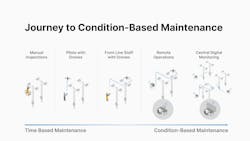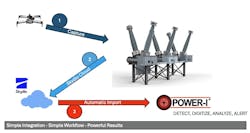Introduction
When pondering the challenges utilities face, a critical question arises: how can we solve the paradox of expanding scope against dwindling resources? Amidst an uncertain future, reducing organizational risk becomes paramount. The answer lies in leveraging drone technology for utility asset monitoring, heralding a new era of condition-based maintenance (CBM) for unparalleled grid resiliency.
Decision-making challenges in utility asset management
Utilities must navigate a labyrinth of internal and external pressures:
- Aging Infrastructure: Legacy systems teeter on the brink of failure.
Budget Constraints: Every dollar spent on operations and maintenance (O&M) is under scrutiny. - Resource Constraints: Increasing demands clash with decreasing workforce numbers.
- Aging Workforce: A generation of experts nears retirement, challenging knowledge transfer to a younger generation that is less inclined to stay at a utility for their entire career
- Stakeholder Expectations: The customer demand for safe, reliable, and affordable power meets the reality of investor ROI expectations.
- Regulatory Pressure: Compliance is not optional in a world of mandatory audits.
- Climate Impact: Increasing extreme weather events threaten grid integrity.
- Digital Transformation: The push for tech adoption comes with its ambiguities.
The justification for prioritization and risk evaluation
Utility decisions are a balancing act, weighed by competing priorities and risks. For instance, Canadian wildfires in the summer of 2023 not only compromised air quality but also posed a dilemma: risk crew health with manual inspections or fall behind on maintenance schedules.
Transitioning to condition based maintenance
Traditional time-based maintenance often leads to premature or belated interventions. In contrast, CBM tailors maintenance to actual asset conditions, informed by comprehensive data collection—a task perfectly suited for drones.
Multiply your workforce
Advanced drone technologies extend the capabilities of utility workforces, enabling easy access to hazardous or hard-to-reach areas and providing real-time data for informed decision-making. From pilot-assisted flights to fully autonomous operations, drones are reshaping how utilities approach asset health assessment on the journey to condition based maintenance.
Manual inspections
Current state with humans in bucket trucks and rappelling and/or climbing to visually confirm asset health face inherent safety risks and inefficiencies
Pilots with drones
Pilots with drones minimize data collection burdens, providing easy access to hard to reach or dangerous locations for more comprehensive and efficient data-capture.
Frontline staff with drones
Front-line staff equipped with user-friendly and autonomous drone technology put experts’ eyes directly on the assets when and where they are needed.
Central digital monitoring
Remote operation of 5G-connected drones provides 24/7 on-site visibility anywhere with the internet, enabling experts to remotely monitor asset health without ever driving to the site
Drones paying dividends for innovative utilities
Drones are being used widely to monitor, inspect, and safeguard the critical infrastructure our civilization runs on; from power generation, power delivery, and substation inspections, drone technology is doing it all, and Innovative utilities are taking notice, implementing drone programs and sharing results that are the envy of decision-makers in the utility industry.
AEP aims to improve reliability and keep employees safe by using drones for initial damage assessment and identifying hot spots in equipment recently revealing an imminent failure that could have resulted in downtime, failed equipment, and the need to get the system back up and running, which would have cost $7-8 million.
PG&E has positioned itself as a leader in the use of drone technology within the utility sector, deploying drones manually and remotely from docks to conduct inspections of power lines, substations, and other infrastructure, inspecting over half of the 55,471 transmission structures inspected that year being done so via drone-captured imagery.
NYPA’s drone program, which has received funding approval for $37.2 million, aims to enhance inspection capabilities, improve safety and efficiency, and position NYPA as a leader in robotic initiatives. Tower inspections can now be completed in about 12 minutes by 2 employees, making the process 12.5 times faster and reducing the need for helicopters, thereby enhancing safety and efficiency.
Southern Company has obtained an FAA waiver allowing for drone inspections at its facilities without onsite personnel, enhancing efficiency and safety by enabling remote inspections from a control center and reducing the need for hazardous on-site evaluations.
ComEd Secured waivers from the FAA to conduct beyond visual line of sight (BVLOS) from drone docks, enabling safe, cost-effective on-site and on-demand surveillance capabilities, supporting grid performance and proactive problem identification to prevent power outages.
Dominion Energy uses drones across its operations for electric transmission operations, power generation inspections, and supporting operations at solar farms and construction sites.
From toys to tools
Addressing utility challenges requires innovative solutions. Drone technology solutions directly tackle issues of aging infrastructure, budget and resource constraints, and knowledge transfer, while also navigating external pressures like stakeholder expectations, regulatory compliance, and climate threats. The shift towards proactive asset management not only prepares utilities for future challenges but also attracts a new generation of talent, ready to build the grid of tomorrow.
Drones have begun to evolve far beyond their initial perception as semi-sophisticated toys. Today, they are practical tools that are reshaping operations across various sectors, including utilities. This transformation underscores the potential of drones to contribute to more streamlined and effective workflows. However, it's important to remain judicious in evaluating their role and impact, recognizing that while drones are indeed valuable tools, their effectiveness is contingent on thoughtful application and integration into existing systems.
About Skydio
Skydio develops innovative drone technologies that are helping transform and modernize the grid of the future. Through a deep partnership and understanding of the challenges faced by utilities, Skydio's solutions facilitate a shift to condition-based maintenance, enabling utilities to make informed decisions about asset health in real time. Skydio empowers utilities to enhance operational efficiency, reduce risks, and achieve remarkable cost savings. By providing real-time, accurate data collection and analysis, Skydio is not just a technology provider but a partner in driving utility innovation and operational excellence.
Learn more about drone solutions for utility asset management.





